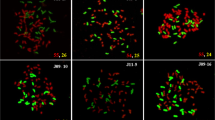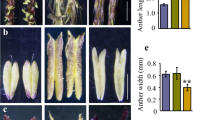Abstract
Erianthus, a related genus grouped under ‘Saccharum complex’ is seriously considered as a potential genetic resource for imparting high biomass production, multi ratooning ability, resistance to major diseases and pests and tolerance to abiotic stresses to sugarcane varieties. However introgression of Erianthus had limited success in the past in view of the high genetic distance between the two genera and the consequent low compatibility of such crosses. The inherent difficulty in precisely identifying the true hybrids from the selfed progenies from such crosses also remains a difficult task. In this article we report the production of an intergeneric hybrid GU04(28) EO2 involving Erianthus and Saccharum. The hybrid was characterized using 5s rDNA markers and evaluated for agro-morphological traits. The chromosome number of the Erianthus procerus × Saccharum officinarum hybrid approximated to 2n + n transmission with elimination of few chromosomes. The hybrid showed relatively low stalk weight and thickness, but had high yield potential in view of the high stalk population. The hybrid also showed high drought tolerance and resistance to red rot disease. This hybrid was backcrossed to a commercial sugarcane variety Co 06027. Erianthus-specific 5s rDNA marker was present in five of the BC1 progenies, thus confirming their Erianthus derivation. The chromosome number of the BC1 progenies ranged from 2n = 88–94, consistent with n + n transmission. The BC1 progenies showed significant improvement in stalk weight and juice sucrose over the F1 hybrid and it may be possible to develop varieties with commercial potential with few more backcrosses. The Erianthus × Saccharum hybrid GU04(28) EO2 is thus a potential source for diversifying the genetic base of the sugarcane varieties as it combines the genomes of two distantly related genera and also in view of its yield potential, red rot resistance and drought tolerance.



Similar content being viewed by others
References
Aitken K, Li J, Wang L, Cai C, Fan YH, Jackson P (2007) Characterization of intergeneric hybrids of Erianthus rockii and Saccharum using molecular markers. Genet Resour Crop Evol 54:1395–1405
Alix K, Paulet F, Glaszmann JC, D’Hont A (1999) Inter-Alu like sequences in Saccharum complex. Theor Appl Genet 99:962–968
Cai Q, Aitken K, Deng H, Chen X, Fu C, Jackson P, McIntyre C (2005) Verification of the introgression of Erianthus arundinaceus germplasm into sugarcane using molecular markers. Plant Breed 124(4):322–328
D’Hont A, Rao PS, Feldmann P, Grivet L, Islam Faridi N, Taylor P, Glaszmann JC (1995) Identification and characterization of sugarcane intergeneric hybrids, Saccharum officinarum × Erianthus arundinaceus, with molecular markers and DNA in situ hybridization. Theor Appl Genet 91:320–326
Fischer RA, Maurer R (1978) Drought resistance in spring wheat cultivars. I. Grain yield response. Aust J Agric Res 29:897–907
Fischer KS, Wood G (1981) Breeding and selection for drought tolerance in tropical maize. In: Proceeding Symp. on Principles and Methods in Crop Improvement for drought resistance with emphasis on rice. IRRI, Philippines, 23–25th May 1981
Fukuhara S, Terajima Y, Irei S, Sakaigachi T, Ujihara K, Sugimoto A, Matsuoka M (2013) Identification and characterization of intergeneric hybrid of commercial sugarcane (Saccharum spp. Hybrid) and Erianthus arundinaceus (Retz.) Jeswiet. Euphytica 189:321–327
Jackson P, Henry RJ (2011) Erianthus. In: Kole C (ed) Wild crop relatives: genomic and breeding resources, industrial crops. Springer, Berlin 97–107
Janaki Ammal EK (1941) Intergeneric hybrids of Saccharum. J Genet 41:217–253
Kandasami PA (1964) Studies on intergeneric hybrids of Saccharum spontaneum. Proc. V All India Conf. Sugarcane Res and Dev Workers 407–411
Lalitha R, Premachandran MN (2007) Meiotic abnormalities in intergeneric hybrids between Saccharum spontaneum and Erianthus arundinaceus (Gramineae). Cytologia 72:337–343
Liu WR, Deng ZH, Zhang MQ, Zhou XL, Fu C, Zhang CM (2004) Use and characterization of the genuine intergeneric hybrids from the cross of Saccharum spp. and E. arundinaceum Retz. (3) Cytogenetic analysis for the hybrid and backcross progeny of S. officinarum Land Erianthus section Ripidium. Acta Agron Sinica 30:1093–1096
Lo CC, Chen YY, Huang YJ, Shih SC (1986) Recent progress in Miscanthus nobilisation programme. Proc Int Soc Sugarcane Technol 19:514–521
Mangelsdorf AJ (1983) Cytoplasmic diversity in relation to pest and pathogens. Sugarcane Breed Newsl 45:45–49
Matsuo K, Chuenpreecha T, Ponragdee W, Wonwivachai C (2001) Eco-physiological characteristics and yielding ability of Erianthus spp. JIRCAS Research Highlights
Meade GP, Chen JCP (1977) Cane Sugar Hand Book, 10th edn. Wiley, New York
Nair NV, Selvi A, Sreenivasan TV, Pushpalatha KN, Mary Sheji (2006) Characterization of intergeneric hybrids of Saccharum using molecular markers. Genet Resour Crop Evol 53(1):163–169
Parthasarathy N (1946) The probable origin of the North Indian sugarcanes. MOP Iyengar Commemorative volume. J Indian Bot Soc 133-150
Piperidis G, Christopher MJ, Carroll BJ, Berding N, D’Hont A (2000) Molecular contribution to selection of intergeneric hybrids between sugarcane and the wild species Erianthus arundinaceus. Genome 43(6):1033–1037
Piperidis G, Piperidis N, D’Hont A (2010a) Molecular cytogenetic investigation of chromosome composition and transmission in sugarcane. Mol Genet Genomics 284:65–73
Piperidis N, Chen JW, Deng HH, Wang LP, Jackson PA, Piperidis G (2010b) GISH characterization of Erianthus arundinaceus chromosomes in three generations of sugarcane intergeneric hybrids. Genome 53:331–336
Ram B, Sreenivasan TV, Sahi BK, Singh N (2001) Introgresssion of low temperature tolerance and red rot resistance from Erianthus in sugarcane. Euphytica 122:145–153
Ramdoyal K, Badaloo MGH (2007) An evaluation of interspecific families of different nobilised groups in contrasting environments for breeding novel sugarcane clones for biomass. Proc Int Soc Sugar Cane Technol 26:632–643
Rao JT, Kandasamy PA, Kumari RK (1957) Tannin in root tip as a probable genetic character of Erianthus. Curr Sci 26:219–220
Rao KSS, Kandasamy PA, Batcha MBGR (1963) Cytogenetical studies on certain Saccharum-Erianthus hybrids. Indian J Sugar Cane Res Dev 7(4):213–218
Roach BT (1969) Quantitative effects of hybridization in Saccharum officinarum × Saccharum spontaneum crosses. Proc Int Soc Sugar Cane Technol 13:939–954
Roach BT (1972) Nobilization of sugarcane. Proc Int Soc Sugarcane Technol 14:206–216
Roach BT (1978) Utilization of Saccharum spontaneum in sugarcane breeding. Proc Int Soc Sugar Cane Technol 16:43–57
Sardana HR (2002) Evaluation of Saccharum barberi, S. sinense and Erianthus spp. clones of sugarcane for susceptibility to major borer pests. Ann Plant Prot Sci 10:42–44
Shang KC, Juang PY, Chu TL, Huang ST (1969) A study on the transmission of some important characteristics of Taiwan originated wild cane (Saccharum spontaneum L). Proc Int Soc Sugar Cane Technol 13:968–974
Shanmugha Sundaram K, Krishnamurthi M, Rajeswari S, Sekhar Shini, Shanmughanathan M (2010) Genetic base broadening of sugarcane (Saccharum Spp.) by introgression of genes through intergeneric hybridization. Proc Int Soc Sugar Cane Technol 27:1–9
Sreenivasan TV (1969) Cytogenetic studies in Saccharum and related genera. PhD dissertation submitted to the University of Madras
Wang XH, Yang QH, Li FS, He LL, He SC (2010) Characterisation of the chromosomal transmission of intergeneric hybrids of Saccharum spp. and Erianthus fulvus by genomic in situ Hybridization. Crop Sci 50:1642–1648
Zheng XF, Zhang MQ, Li QW, Lao FY, Deng ZH, Chen RK, Yang YH (2004) Utilization and characterization of the genuine intergeneric hybrids from cross of Saccharum and E.arundinaceum (2): molecular identification of genuine hybrids from the cross of Saccharum and E.arundinaceum. Mol Plant Breed 2:35–42
Author information
Authors and Affiliations
Corresponding author
Rights and permissions
About this article
Cite this article
Nair, N.V., Mohanraj, K., Sunadaravelpandian, K. et al. Characterization of an intergeneric hybrid of Erianthus procerus × Saccharum officinarum and its backcross progenies. Euphytica 213, 267 (2017). https://doi.org/10.1007/s10681-017-2053-7
Received:
Accepted:
Published:
DOI: https://doi.org/10.1007/s10681-017-2053-7




